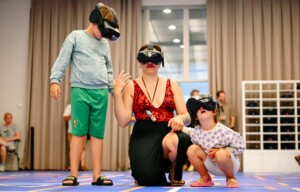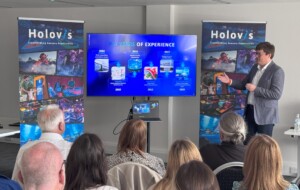International audio-visual experts, Electrosonic, has designed and supplied the New York Historical Society Museum with all of their audio, video and control systems.
The museum, which specialises in the cultural and political history of New York, has undergone a $70 million renovation, with Electrosonic providing its state of the art technology.
Related: Electrosonic Profile / Electrosonic’s Audiovisual Technology for Dutch Football Fans at Ajax Experience / World’s Fairs: EXPOs in the 20th and 21st Centuries (part 2)
Admissions
A part of this multi-million dollar improvement is a 3, 400 square foot area, which combines museum admissions, the adjacent Robert H. and Clarice Smith New York Gallery for American History and Robert H. Smith Auditorium. The project was designed by Platt Byard Dovell White Architects and Lee H. Skolnick Architecture + Design Partnership and is unique insomuch as it is the only children’s library and history museum in New York.
 The Robert H. and Clarice Smith New York Gallery of American History forms the new Great Hall: “It’s an impressive admissions area that fascinates visitors with multiple multimedia exhibits, ” says Andrew Kidd, Electrosonic’s sales consultant.
The Robert H. and Clarice Smith New York Gallery of American History forms the new Great Hall: “It’s an impressive admissions area that fascinates visitors with multiple multimedia exhibits, ” says Andrew Kidd, Electrosonic’s sales consultant.
Smooth, semi-mirrored glass digital signage cases are stationed above the theatre entrance and over the admissions desk; designed by Lee H. Skolnick Architecture & Design and assembled by DCL in Boston, using Ad Notam glass, the signs supply guests with information about the museum’s activities.
AV consultant TAD, Electrosonic supplied C-Nario signage software and players, which Unified Field used to craft the signage content.
By the admissions desk is an interactive ‘living painting’ displayed on a 2 x 5 landscape-oriented video-wall, utilising ten narrow-mullion Planar Matrix 55-inch monitors supplied and installed by Electrosonic, with hidden Dell computers which bring the static picture to life.
Thanks to a Microsoft Kinect camera, which can track the movement of visitors, the computers change the content of the painting. As guests continue to gather around the moving ‘painting’, it further comes to life with a sequence of events that ends with the artistic image returning to its original form.
The Smith Gallery
In the Smith Gallery, the New York Rising exhibit uses five rotating display housing containing portrait oriented 46-inch Samsung touchscreens installed by Electrosonic to display features and artifacts. Visitors can rotate the touchscreen cases, to select the image of the artifacts on the wall behind the screen to reveal further information.
A further 6 pairs of 55 inch screens, displaying the museums treasures, adorn the east and west building columns, showing a selection of the museums assets with four Sony Vajo 22 inch touchscreen, to further equip visitors with more information.
The Robert H. Smith Auditorium
An 18 minute, multi-screen media experience titled “New York Story” graces the 420-seat Robert H. Smith auditorium during the day. Electrosonic have set up a three-projector ‘blend system’ in the auditorium, incorporating Christie WU12K-M projectors, fed by Extron JMP 9600-2K JPEG2000 video players, all of which are powered by a Medialon show control system.
The front of the stage has four 6-foot wide screens, which can move up and down and expand to a total of ten, as the tale develops.
During the show, movable screens rise to unveil the centre portion of a 72-foot wide back-screen showing a single image. Towards the end, the entire 72 foot screen is revealed. LA Propoint and PDO provided the stage machine ry for display surfaces, whilst Electrosonic designed the projection system to cover the three screen planes, which can all be used at the same time. Electrosonic and Donna Lawrence Productions did full size feasibility tests at Electrosonic’s Burbank facility a year before installation.
ry for display surfaces, whilst Electrosonic designed the projection system to cover the three screen planes, which can all be used at the same time. Electrosonic and Donna Lawrence Productions did full size feasibility tests at Electrosonic’s Burbank facility a year before installation.
Electrosonic installed 38 Renkus-Heinz speakers for surround sound, augmented by two double 15” JBL sub-woofers. Digital sound processing has been supplied by MediaMatrix Nion.
Everything from power-point presentations to a complete band set up is possible within the theater thanks to an AMX- controlled full presentations system complete with a Panasonic projector, with connections for up to 18 microphones, Blu-ray, DVD players and podium control for the Power-point computer. A touchscreen control position for Medialon and AMX can also be found in the theatre’s mezzanine, which also features a Yamaha LS9-32 sound mixing board.
Outside the theater, Electrosonic equipped the Smith Gallery and Dexter Hall with fixed speakers and portable special events AV systems that allow presentation in either gallery with either local or theater generated audio and video. The portable part of the system can be used as a stand-alone setup.
Electrosonic’s design consulting team provided design services for the auditorium, as well as portions of the Great Hall and Dexter Hall. Donna Lawrence and the Electrosonic design team collaborated on the auditorium’s schematic and design development, creating two full size models of a section of the theatre to test design against the unique demands of the multi-screen projection.
The design consulting team had to devise an innovative solution for the auditorium’s sound system, since there was limited space for speakers behind the main screen. The speakers were hidden in the apron and ceiling of the stage which also gives the audience the impression that the sound is coming from the centre of the screen.
DiMenna Children’s History Museum
Lee H Skolnick designed features for the DiMenna museum with Explus, Superior Exhibits, Murphy Catton and DCI responsible for the fabrication. Unified Field were responsible for the video media and interactive software.
Electrosonic’s project managers were Jackson Benedict and Ellen Simich, and commission engineer and programmer was Tony Peugh.













